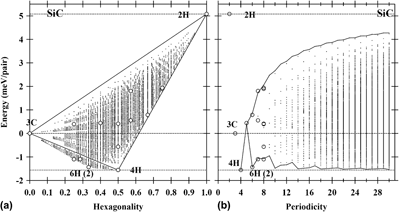Article contents
Comparative studies on total energetics of nonequivalent hexagonal polytypes for group IV semiconductors and group III nitrides
Published online by Cambridge University Press: 06 July 2012
Abstract

We report the results of the systematic investigation into correlations between energetics and hexagonal stacking configurations for carbon, silicon, SiC, BN, AlN, GaN, and InN polytypes with sp3-bonded networks. The atomistic geometry, energetics, and electronic structure for these compounds with up to the periodic stacking length of L = 8 have been carefully calculated based on the density functional theory within the generalized gradient approximation (GGA). Using the Axial Next-Nearest-Neighbor Ising model extracted from the GGA calculations, we have also studied the energetics for more than 6 million kinds of nonequivalent stacking polytypes with up to L = 30, whose configurations have been deduced by the efficient polytype generation algorithm [E. Estevez-Rams and J. Martinez-Mojicar, Acta Crystallogr., Sect. A: Found. Crystallogr. 64, 529 (2008)], and illustrated some trends of structural and energetic properties for these compounds.
- Type
- Articles
- Information
- Journal of Materials Research , Volume 28 , Issue 1: Focus Issue: Silicon Carbide – Materials, Processing and Devices , 14 January 2013 , pp. 7 - 16
- Copyright
- Copyright © Materials Research Society 2012
References
REFERENCES
- 5
- Cited by




